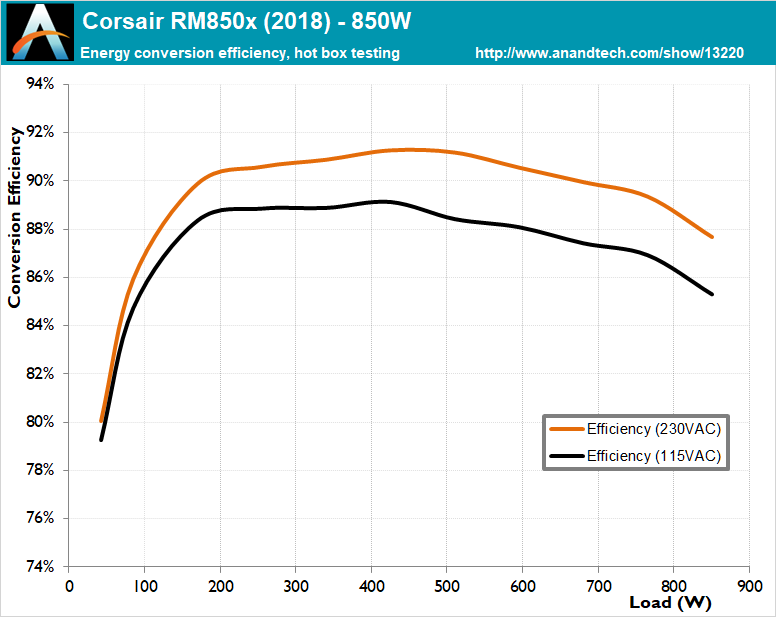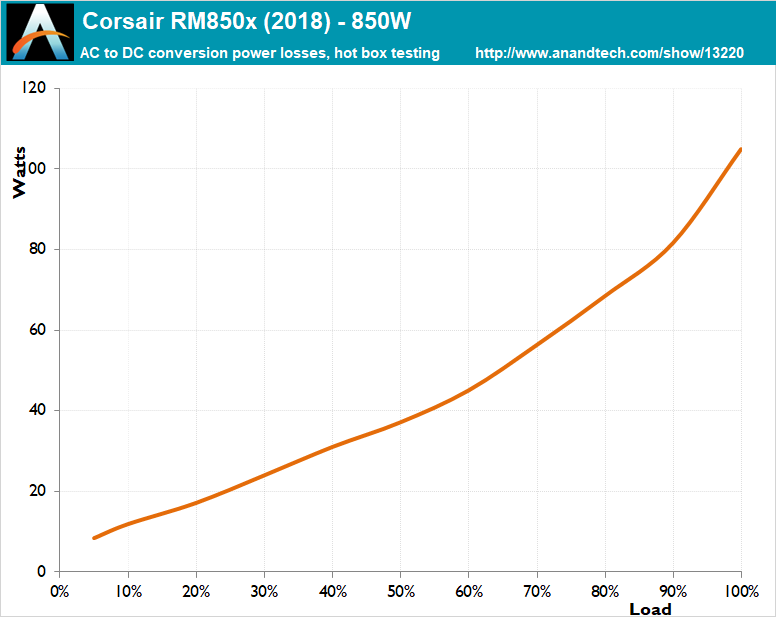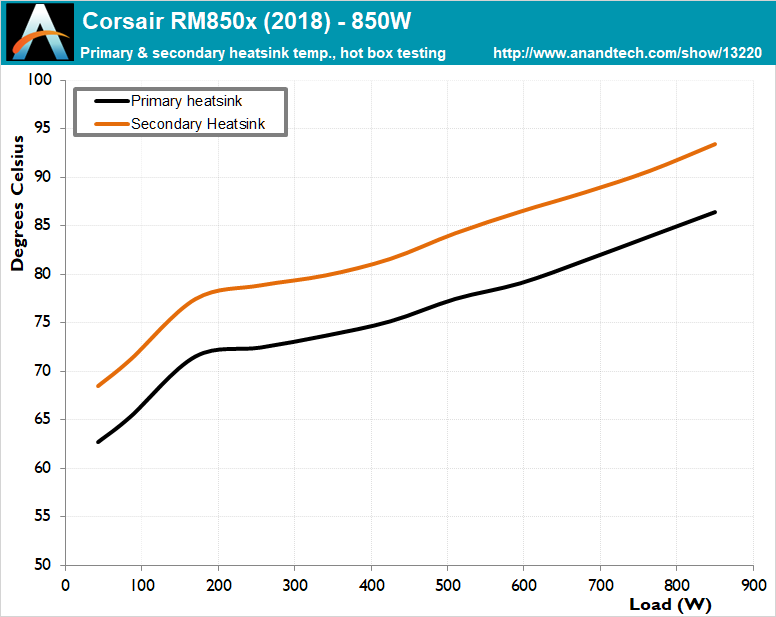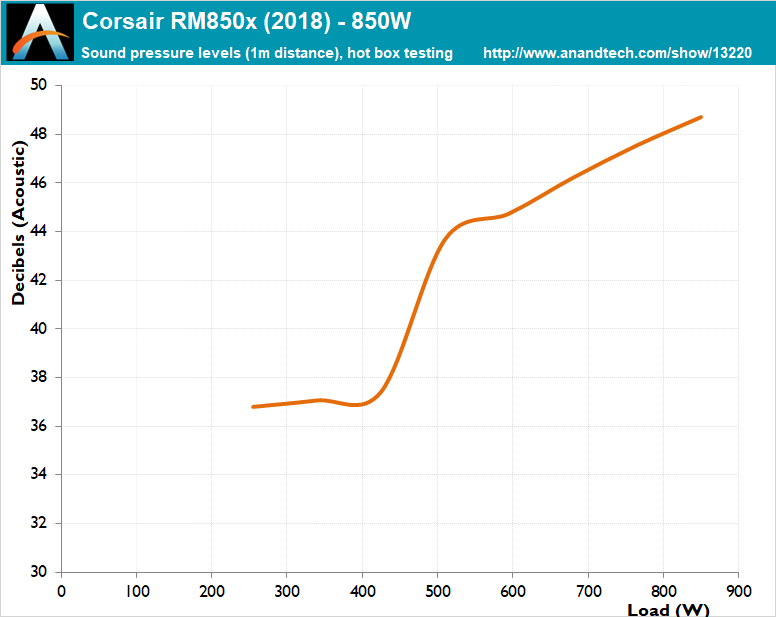The Corsair RM850x (2018) PSU Review: Exceptional Electrical Performance
by E. Fylladitakis on August 22, 2018 8:00 AM EST- Posted in
- Cases/Cooling/PSUs
- Corsair
- PSUs
- 850W
- Modular
Hot Test Results
Even though Channel-Well Technologies is better known for their cost-effective designs, the platform that they developed for the RM850x has rather outstanding electrical performance. Even when subjected to high ambient temperatures, the power quality of the RM850x is fantastic, with a maximum ripple of just 12 mV on the 12V line under maximum load. Furthermore the maximum ripple recorded on the 3.3V and 5V lines does not exceed 12 mV either. The voltage regulation is fantastic too, with the all of the voltage lines staying within 0.6-0.7% across the nominal load range.
These figures are extremely low for a unit with this kind of output, regardless of its retail price. We have only tested a handful of products that can compete with the new RM850x in terms of power quality and they all were significantly more expensive.
| Main Output | ||||||||
| Load (Watts) | 172.41 W | 430.69 W | 643.07 W | 856.73 W | ||||
| Load (Percent) | 20.28% | 50.67% | 75.65% | 100.79% | ||||
| Amperes | Volts | Amperes | Volts | Amperes | Volts | Amperes | Volts | |
| 3.3 V | 2.23 | 3.37 | 5.57 | 3.36 | 8.36 | 3.35 | 11.14 | 3.35 |
| 5 V | 2.23 | 5.13 | 5.57 | 5.12 | 8.36 | 5.11 | 11.14 | 5.11 |
| 12 V | 12.62 | 12.16 | 31.56 | 12.15 | 47.34 | 12.09 | 63.12 | 12.08 |
| Line | Regulation (20% to 100% load) |
Voltage Ripple (mV) | |||||
| 20% Load | 50% Load | 75% Load | 100% Load | CL1 12V |
CL2 3.3V + 5V |
||
| 3.3V | 0.4% | 6 | 6 | 8 | 8 | 6 | 10 |
| 5V | 0.4% | 8 | 10 | 12 | 10 | 8 | 10 |
| 12V | 0.7% | 8 | 12 | 12 | 12 | 14 | 12 |
The impact of high ambient temperature is not apparent when looking at the power quality figures but the conversion efficiency drop is significant, especially under heavy loads. With an ambient temperature between 45 °C and 50 °C, the average nominal load (20-100%) efficiency drops down to 90.2%/88.1% during this test with an input voltage of 230V/115V AC respectively. The drop is not consistent across the entire load range, with the RM850x performing significantly worse when heavily loaded for extended periods of time, suggesting that its active components are struggling under such adverse operating conditions.
Strangely, the thermal profile of the RM850x hardly changed at all while the unit was operating inside our hotbox. The fan did not start before the load was greater than 200 Watts but it was noticeably faster when it did, yet barely audible. This changes quickly when the load surpasses 450 Watts, where the fan's speed increases abruptly and reaches clearly audible noise levels. This is necessary to maintain reasonable and reliable operating temperatures, which the RM850x does, yet the figures are relatively high when the unit is operating at or near its maximum capacity. The RM850x should be able to maintain reliable operation under such operating conditions, yet the high temperatures clearly do have an impact on its energy conversion efficiency.















14 Comments
View All Comments
austinsguitar - Wednesday, August 22, 2018 - link
picked this thing up for 99 dollars last week at best buy. Super quiet most of the time. Love it... capacitors in the wires are huge...Cellar Door - Wednesday, August 22, 2018 - link
It would cost Corsair less then $0.50 to include a ball bearing version o the fan.philehidiot - Thursday, August 23, 2018 - link
Do remember volume. That $0.50 might do a couple of things. Firstly when multiplied by a lot of units that becomes $0.50 x lots. Which is (($0.50)lots). Which is a lot. The other issue is if you push that onto the consumer then it may send the price over a psychological threshold which has been shown to lead to reduced overall sales. Whilst the individual is rational and when informed would rather spend $0.50 for the nice fan, the herd acts like a bunch of morons who need to be carefully led.This presents a problem because cows are stupid, but you want their milk.
Cellar Door - Thursday, August 23, 2018 - link
Terrible analysis - higher volume means lower overall costs. As Corsair already uses higher quality fans in other units.philehidiot - Wednesday, June 30, 2021 - link
My comeback is a few years late. But you can only reduce costs with economies of scale so far. Some parts are fundamentally more expensive and the producers still need to make a profit. Last company I saw focus purely on volume, relying on economies of scale, went very bust very quickly. As I said, it might be that psychological threshold or just plain budget that they have to keep under. The other models might have had room in the budget for the ball bearing fan. Or, quite possibly, the market for power supplies of this level just doesn't use the fan type as a discriminator. They use ripple, efficiency and so on.I trust that you won't be coming back to this several years down the line and shall therefore assume I win the argument. Victory!
austinsguitar - Saturday, August 25, 2018 - link
the fan is ball bearing?Batmeat - Wednesday, August 22, 2018 - link
Third paragraph had the word "bifurcated" in it back to back.Ryan Smith - Wednesday, August 22, 2018 - link
Thanks!mgabee - Thursday, August 23, 2018 - link
Best PSU, beside the EVGA G3 series of course. Jonnyguru makes Corsair PSUs more brilliant with this 2018 upgrade. I have the RM550x: the quality is insane, deadly silent, Vcore drop halved under load. It is definitely a 10yr long PSU with the best price/performance ratio.IgorM - Thursday, August 23, 2018 - link
I must disagree with crypto mining part. We have at least 3 Rmx 850 and at least 20 Rmx 1000 working almost a year with pretty harsh conditions, up to 43 C in the room, almost full load, and none died yet and works excellent. We also have LC power PSUs, because supply of Corsair was limited at the time, and they are dying often.